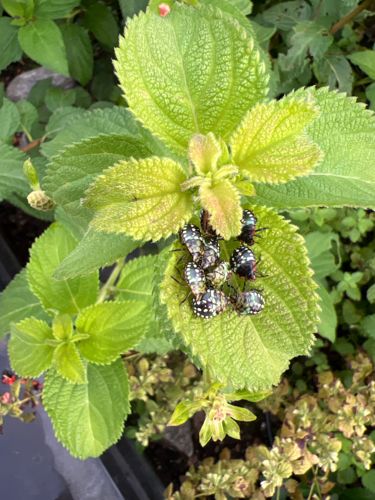Stink Bug Nymphs (likely Brown Marmorated Stink Bug nymphs given their appearance)
Scientific Name: Halyomorpha halys (most likely, based on coloration and speckling, though identification from nymphs can be tricky and requires careful examination and potentially geographic context)
Order & Family: Order: Hemiptera, Family: Pentatomidae (Stink Bugs)
Size: Nymphs vary in size depending on their instar, generally ranging from 1-12 mm. Adult stink bugs typically range from 12-17 mm (e.g., for Brown Marmorated Stink Bug).

Natural Habitat
Stink bugs are found in a wide variety of habitats, including agricultural fields, orchards, gardens, woodlands, and urban areas. They are often found on host plants where they feed and lay eggs. The Brown Marmorated Stink Bug, in particular, is known to overwinter in homes and other structures.
Diet & Feeding
Stink bugs are primarily herbivorous, feeding on a wide variety of plants, including fruits, vegetables, and field crops. They pierce plant tissues with their needle-like mouthparts (stylets) and suck out plant juices. The exact diet depends on the species, but many are polyphagous, meaning they feed on many different types of plants.
Behavior Patterns
These are nymphs of stink bugs. Stink bugs undergo incomplete metamorphosis, meaning they hatch from eggs, develop through several nymphal instars, and eventually become adults without a pupal stage. Nymphs often cluster together, as seen in the image, especially in early instars. As they grow, they may disperse more.
Risks & Benefits
Risks: Many species of stink bugs are significant agricultural pests, causing damage to crops by feeding, which can lead to deformed fruits, vegetables, and seeds, or even complete crop loss. They can also be a nuisance pest when they aggregate in homes in search of overwintering sites, and they release a foul odor when disturbed. Benefits: While many are pests, some species of stink bugs are predatory and can be beneficial by feeding on other insect pests. However, the species pictured appears to be a plant feeder.
Identified on: 8/28/2025